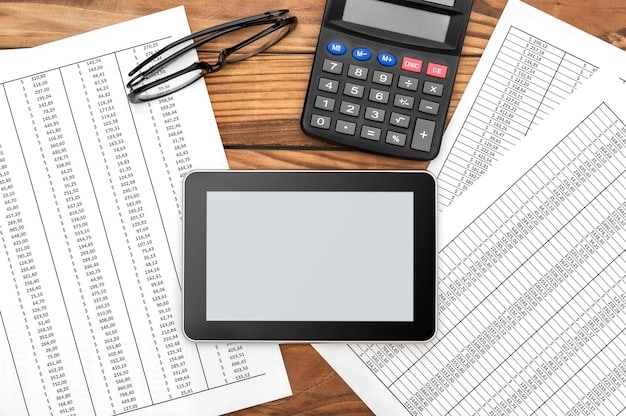Can Bankruptcy Help You? Chapter 7 & 13 Guide for 2025

Understanding bankruptcy options like Chapter 7 and Chapter 13 can provide a fresh financial start in 2025, offering debt relief through liquidation or structured repayment plans tailored to individual circumstances and financial stability.
Facing overwhelming debt? Wondering if bankruptcy could be the solution for you in 2025? This guide breaks down the complexities of Chapter 7 and Chapter 13, helping you understand if Can Bankruptcy Help You? Understanding Chapter 7 and Chapter 13 in 2025 and how these options can pave the way for a brighter financial future.
Understanding Bankruptcy: A 2025 Overview
Bankruptcy is a legal process offering individuals and businesses overwhelmed by debt a chance to start anew. In 2025, the core principles remain the same, but understanding the nuances of Chapter 7 and Chapter 13 is crucial for navigating this complex landscape.
Let’s delve into what bankruptcy entails and how it might be a viable option for you.
What is Bankruptcy?
Bankruptcy, in its simplest form, is a legal declaration of inability to pay debts. It’s governed by federal law, providing a structured path for debtors to either liquidate assets to repay creditors (Chapter 7) or create a repayment plan over a period of time (Chapter 13).
- Chapter 7: Involves liquidating non-exempt assets to pay off debts.
- Chapter 13: Allows debtors to repay debts over a 3-5 year period under a court-approved plan.
- Credit Counseling: Often required before filing, to explore alternatives and ensure bankruptcy is the best option.
Bankruptcy isn’t a one-size-fits-all solution. The right chapter depends on your income, assets, and the type of debt you carry.
Bankruptcy provides a legal framework to address overwhelming debt. Understanding its basic principles helps individuals determine if it’s a suitable option for their financial situation in 2025.
Chapter 7 Bankruptcy: A Clean Slate?
Chapter 7 bankruptcy, often referred to as “liquidation bankruptcy,” offers a way to wipe out most unsecured debts. However, it does involve liquidating assets to repay creditors.
Let’s explore the eligibility requirements, the process, and what debts are typically discharged under Chapter 7.

Eligibility for Chapter 7
To qualify for Chapter 7, your income must be below a certain threshold, determined by a “means test.” This test assesses whether you have sufficient income to repay your debts.
The Chapter 7 Process
Once you file for Chapter 7, an automatic stay goes into effect, temporarily halting most collection actions. You’ll then need to provide a detailed list of your assets and debts.
- Meeting of Creditors: A meeting where creditors can ask you questions about your finances.
- Asset Liquidation: A trustee appointed by the court may sell non-exempt assets to pay creditors.
- Debt Discharge: After the process is complete, most of your unsecured debts are discharged, meaning you are no longer legally obligated to pay them.
Chapter 7 can provide a quick path to debt relief, but it comes with the potential loss of assets. Careful consideration is vital before proceeding.
Chapter 13 Bankruptcy: A Repayment Plan
Chapter 13 bankruptcy allows individuals with regular income to create a repayment plan to pay off their debts over a period of three to five years. It can be a good option if you want to keep your assets but need help managing debt.
Let’s look at the advantages, the repayment plan structure, and how it differs from Chapter 7.
Benefits of Chapter 13
Chapter 13 offers several advantages, including the ability to keep your assets, catch up on missed mortgage or car payments, and potentially discharge some debts that are not dischargeable in Chapter 7.
The Repayment Plan Structure
Under Chapter 13, you propose a repayment plan to the court. The plan must be feasible, meaning you need to have enough income to make the required payments.
Chapter 13 provides a structured approach to managing debt and keeping assets, requiring careful budgeting and commitment to the repayment plan.
Navigating the Means Test
The “means test” is a crucial component of determining eligibility for Chapter 7 bankruptcy. It compares your income to the median income in your state to assess your ability to repay debts.
Let’s break down how the means test works and what factors are considered.
Understanding the Calculation
The means test calculates your average gross income over the six months prior to filing. If your income is below the state median, you generally qualify for Chapter 7.

Deductions and Exceptions
Even if your income is above the median, you may still qualify if you can deduct certain expenses, such as medical bills, childcare costs, and mortgage payments.
- Consult with an Attorney: A bankruptcy attorney can help you navigate the complexities of the means test.
- Accurate Financial Records: Keep thorough records of your income and expenses.
- State-Specific Guidelines: Be aware of the median income thresholds in your state.
Understanding the means test is essential for determining Chapter 7 eligibility, and consulting with a professional can ensure accurate calculations and informed decisions.
Life After Bankruptcy: Rebuilding Credit
Filing for bankruptcy can significantly impact your credit score. However, it’s not the end of the world. There are steps you can take to rebuild your credit and regain financial stability.
Let’s explore strategies for improving your credit score after bankruptcy.
Secured Credit Cards
Consider applying for a secured credit card. These cards require a security deposit, which serves as your credit limit, making them easier to obtain after bankruptcy. Timely payments will help rebuild your credit.
Responsible Financial Habits
Adopt responsible financial habits, such as creating a budget, paying bills on time, and avoiding unnecessary debt. These actions demonstrate to lenders that you are a reliable borrower.
Rebuilding credit after bankruptcy takes time and effort. By adopting responsible financial habits and using credit wisely, you can gradually improve your score and access better financial opportunities.
Bankruptcy Alternatives: Exploring Your Options
Bankruptcy isn’t the only solution for debt problems. There are alternative strategies to explore, such as debt consolidation, debt management, and credit counseling.
Let’s consider these options and their potential benefits:
Debt Consolidation
Debt consolidation involves taking out a new loan to pay off multiple existing debts. This can simplify your payments and potentially lower your interest rate.
Credit Counseling
Non-profit credit counseling agencies can provide guidance on budgeting, debt management, and negotiating with creditors. They can help you create a plan to repay your debts without resorting to bankruptcy.
Exploring bankruptcy alternatives can offer relief without the long-term impact on your credit. Consider all available options before making a decision.
| Key Point | Brief Description |
|---|---|
| ⚖️ Chapter 7 | Liquidation of assets to discharge most unsecured debts. |
| 💰 Chapter 13 | Repayment plan over 3-5 years; allows keeping assets. |
| 📝 Means Test | Determines eligibility for Chapter 7 based on income. |
| 🏦 Credit Rebuilding | Strategies include secured cards and responsible habits. |
Frequently Asked Questions
▼
Certain debts, such as student loans, some taxes, and domestic support obligations (child support and alimony), are typically not dischargeable in bankruptcy. It’s essential to understand which debts remain after discharge.
▼
A Chapter 7 bankruptcy can remain on your credit report for up to 10 years, while a Chapter 13 bankruptcy typically stays for 7 years. The impact lessens over time as you rebuild your credit.
▼
Whether or not you can keep your car depends on several factors, including the chapter you file under and whether you’re current on your payments. Chapter 13 often allows you to keep your car with a repayment plan.
▼
An automatic stay is an injunction that takes effect immediately upon filing for bankruptcy. It temporarily stops most collection actions, lawsuits, and foreclosures, providing immediate relief from creditor pressure.
▼
While you can file for bankruptcy without an attorney, it’s highly recommended to seek legal advice. An attorney can guide you through the process, ensure you understand your rights and obligations, and help you avoid costly mistakes.
Conclusion
Understanding whether Can Bankruptcy Help You? Understanding Chapter 7 and Chapter 13 in 2025 requires a thorough assessment of your financial situation and careful consideration of your options. Bankruptcy is a powerful tool that, when used wisely, can provide a path to financial recovery. However, it’s essential to explore all alternatives and seek professional guidance to make informed decisions that align with your long-term financial goals.





